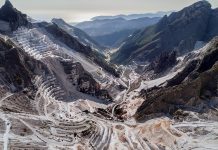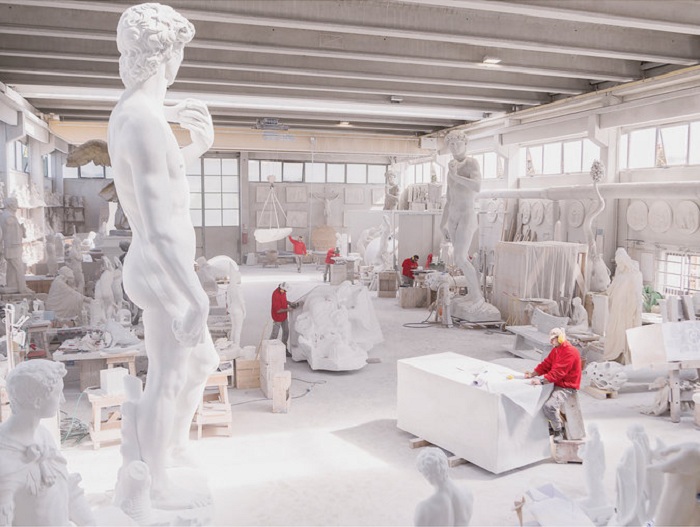The Majestic Marble Quarries of Northern Italy

What we admire as pristine white stone was born hundreds of millions of years ago in overwhelming darkness. ‘‘Marmo,’’ the Italians call it — an oddly soft, round word for such a hard and heavy material. Some eons before, tectonic jostling raised a great spine of mountains in southern Europe. Up went the ancient sea floor, and the crystallized creatures went with it. In some places they rise more than 6,000 feet.
In Italy’s most marble-rich area, known as the Apuan Alps, the abundance is surreal. Sit on a beach in one of the nearby towns (Forte dei Marmi, Viareggio), and you appear to be looking up at snow-covered peaks. But it is snow that does not melt, that is not seasonal.
Hundreds of quarries have operated in the Apuan Alps since the days of ancient Rome. These quarries are far off of Italy’s most-traveled tourist routes, so few visitors see them; most of us know Italian marble mainly as an endpoint in the chain of consumption. The quarries themselves, are their own isolated world: beautiful, bizarre and severe. It is a self-contained universe of white, simultaneously industrial and natural, where men with finger-nubs stand on scenic cliffs conducting tractors like symphony orchestras.

Over the centuries, the strange geology of the marble mountains has produced an equally strange human community — strange even by the standards of Italy’s fractious regional subcultures. The people there live in white towns, breathing white dust, speaking their own dialects, nursing their own politics. There is a proud history, in and around Carrara, of anarchism and revolt.
Although the tools of extraction have changed over the centuries the fact remains: Large pieces of white stone, cut and hauled to distant places, function as a sign of wealth and power. Like gold, marble is a special form of embedded wealth, visually striking and deeply impractical. Today Italy’s marble tends to move farther than it did before — not just 200 miles to Rome or 700 miles to London but 3,000 miles to Abu Dhabi and 4,000 miles to Mumbai and 5,000 miles to Beijing.

The centers of wealth have shifted, as they always will, and the marble follows, as it always has. The last decade has coincided with feverish marble-based construction, in particular, around Mecca in Saudi Arabia. In 2014, the Saudi Binladin Group, one of the region’s major construction firms, bought a large stake in one of Carrara’s largest quarries. The famous white stone is now used not in small batches for art but in bulk for huge building projects: mosques, palaces, malls, hotels.

How long can it hold out? Like North American timber or Antarctic ice, Italy’s marble is not an infinite resource. We will, eventually, reach the end of our ancient fund of calcified creatures, and the process that transformed them into stone is not likely to recur on any time scale we can imagine.
And although the white stone itself will almost certainly outlive its current quarriers, as it outlived the ancient Romans and Michelangelo, most of it will no longer be in the Apuan Alps: It will be scattered in this worldwide diaspora — in sinks, tiles, altars, skyscraper lobbies, busts.




Source: www.nytimes.com
The post The Majestic Marble Quarries of Northern Italy appeared first on StoneNews.eu.
10:25 pm December 21, 2018

Atieh Pasargad Amethyst International Trade Company ( سنگ پاسارگاد )
Address: Old Qom kashan Road – Omid Stone City – Qom – Iran
Email:
Ali Shafiei – CMO » Ali@pasargadstone.com
Hossein Shafiei – CEO » Hossein@pasargadstone.com
(+98) 912 553 5362
Ali Shafiei – CMO
Chief Marketing Officer
(+98) 912 251 8055
Hossein Shafiei – CEO
Chief Executive Officer
سنگ پاسارگاد – Pasargad Stone All Right Reserved
Designed and Developed by Branex.ir برانکس
